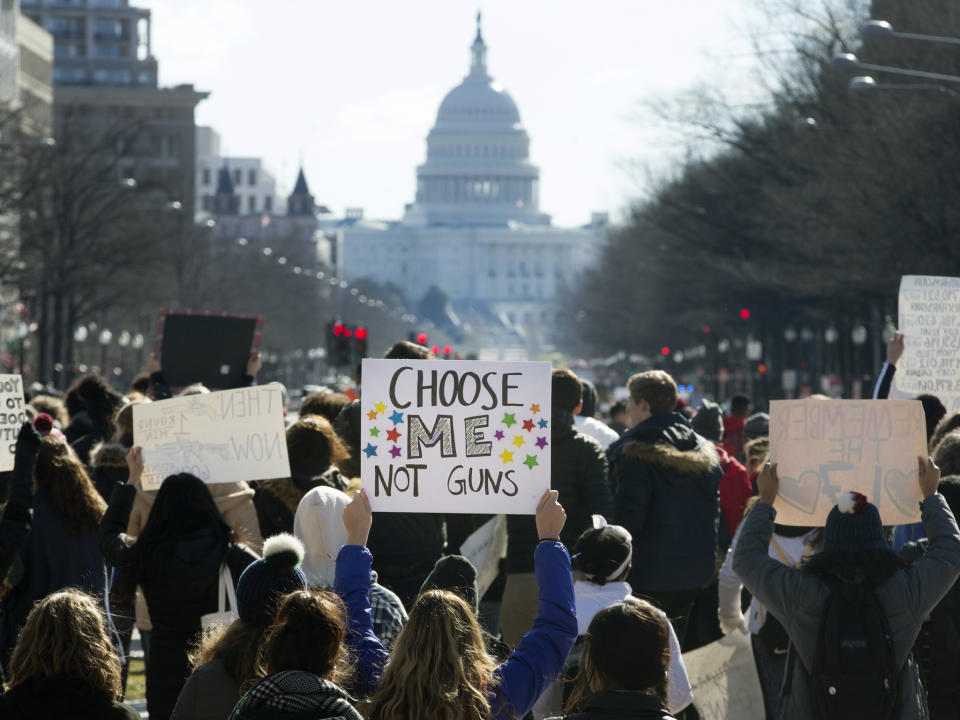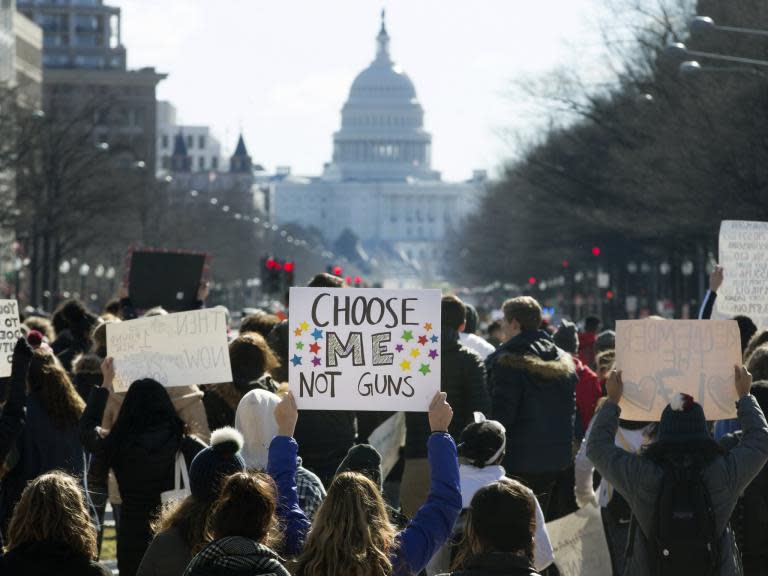'Thoughts are not working': High school students walk out on 19th anniversary of Columbine to protest gun violence
Students across the United States have walked out of class to mark the 19th anniversary of the Columbine High School massacre and demonstrate against gun violence in America.
The student demonstrations — planned in communities nationwide from Los Angeles, to Florida, and New York — carry with them a renewed urgency following the shooting at Marjory Stoneman Douglas High School in February, where 17 people were killed in what is now the deadliest high school shooting since the Columbine attack 19 years ago.
In New York’s Washington Square Park, several thousand students crowded in front of the park’s iconic marble arch. Most of the demonstrators were not alive when two students killed 13 people at Columbine High School nearly two decades ago, shocking the nation and forcing schools to grapple with the new reality that their classes may be next.
“I don’t know what a world looks like without school lock downs. I don’t know what a wold looks like without the looming threat of gun violence in schools, without us being taught … to ‘hide under cover, or hide under this specific door because then the shooter won’t see you,” Harrison Picallo, a 16-year-old sophomore at Brooklyn Technical High School told The Independent.
“These things have always been my life.”
Jonathan Green, an early speaker from LaGuardia High School in Manhattan, boomed one of the central messages — and threats — of the demonstrators to the politicians in Washington and statehouses around the country where gun control legislation remains little more than an intangible concept.
“We’re here to say: Now is the time,” he said. “Your thoughts are not working and your inaction will not be tolerated anymore.”
“Some of us will be able to vote in 2018,” he said, to thunderous applause.
“Most of us will be able to vote in 2020,” he continued. “We will not forget.”
In communities across the country, students held their own demonstrations as well, maintaining momentum for the movement while providing the opportunity to students to register to vote before November, when polls will open for the midterm elections.
Students at a Kansas City area high school were pictured walking along their track with wooden crosses. In Lafayette, Indiana, students left class carrying signs that read “protect me not your guns”. They left school in Arlington, Virginia; in Nashville, Tennessee; in Grand Blanc, Michigan; in Tucson and Phoenix, Arizona; in Souther California; and, of course, in Parkland, Florida.
Maya Brady-Ngugi, an 18-year-old senior at Bard High School in Manhattan, emphasised that the issue is not just a mass school shooting problem. It is one that touches on lives in all communities, she said, and the current movement must embrace an intersectional approach to make sure that it’s not just in white and affluent communities where gun violence is ended.
“Every single time there is a shooting of a black person, and I hear about it, I’m personally affected by that,” Ms Brady Ngugi, who is black, said. “ There are black people who are dying, and people, honestly, don’t care. I could die and there would just be nothing done.”
The walkouts follow after months of intense debate surrounding America’s gun laws, led by students including those who survived the Parkland shooting on Valentine’s Day.
One month after that shooting, students held a similar school walkout to the one Friday, calling for an end to the gun violence epidemic that impacts all communities — from the affluent city of Parkland to struggling minority communities in the south side of Chicago.
“We hear about this every day. Ever since I was a child, I remember hearing about Columbine, I remember hearing about Sandy Hook [in 2012] – I was in 7th grade – and now I’m a senior, and this is still happening. I really don’t know why it is still happening,” Nande Trant, a 17-year-old senior in Brooklyn, told The Independent at the March walkout. “It needs to stop.
Following that walkout, hundreds of thousands of people marched in Washington and across the country for the March for Our Lives demonstration that called on politicians to change gun laws — or face the wrath of a young and emerging electorate that organisers are pushing to register for the first time.
The pressure from students has led so far to limited successes in statehouses across the country.
In Florida, politicians passed passed rare gun control measures that lifted the age required to buy a firearm, while also allocating funds to boost school security. In Vermont, the state legislatures passed a series of gun control measures for the first time, including one that allowed authorities to take guns from a man who planned a school shooting, but was caught. In New York, Governor Andrew Cuomo pushed for and implemented measures that allow courts to take firearms from people convicted of domestic violence abuses.
“We need greater and better gun control laws,” Christopher Lane, an 11-year-old 6th grade student at Kipp Infinity Middle School and a keynote speaker at the New York walkout, said. “Even though the Second Amendment says you have the right to bear arms, it doesn’t mean you have the right to shoot up a school with an AR-15, or a weapon of war.”
Ian Desoucey, a 17-year-old senior at Brooklyn Technical High School who will be of voting age by the coming midterm elections in November, said that the expectation that the energy to change gun laws would diminish are ill-placed. He was organizing an event on the 19th anniversary of a high school shooting, after all.
“The fact of the matter is it’s not going to peter out because gun violence isn’t going anywhere,” he said. “Even if our organizers sputter out, there’s going to be another shooting. This isn’t going away. It’s not going away, so we need to do something.”

 Yahoo News
Yahoo News 

